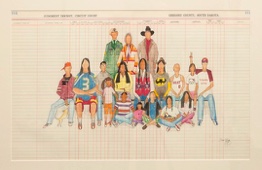Click the logo to go to the Lakota Emergence
homepage
When Tokahe’s family and the other six families emerged from Wind Cave, they were Pte people. In the region of the pines, the adults learned skills, such as hunting, cooking, tanning and sewing, but they were still Pte people. Their acquired skill sets were merely habits. But as the people multiplied and the skills were shared and taught to their children, those intergenerational habits became cultural markers for differentiating Lakota people not only from the Pte people, but from all other peoples.
The final passage of the exhibit is the final sentence of the emergence narrative and the beginning of the Lakota people: “Thus Tokahe and his friends were the first people on the world and their children are the Lakota.” For Dwayne Wilcox, the passage is an opportunity to celebrate Lakota people of today in all their complex diversity, through the traditional medium of ledger art whose roots are anchored in petroglyphs and pictographs on rock walls. “From shaved heads to braids, from hipsters to soldiers, we are people of today,” Dwayne says with a smile. His deceptively sophisticated drawing is of a modern family posing for a portrait. But instead of being captured by a camera, this contemporary extended family portrait is illustrated with colored pencils, thereby connecting it to the Lakota traditions of ledger drawings, winter counts, tipi covers and petroglyphs. Family members are connected to each other and to their ancestors and descendants by these traditions and by narratives such as the one recounting the emergence of Lakotas onto this earth.
Instead of focusing on their idiosyncrasies, Dwayne depicts the family members without distinct facial features: “We’re all interchangeable in our looks, but our realities are the same.” Humor, love and a determination to survive are present in all Lakota families. Evident throughout the lives of Lakotas today are reminders of traditional Lakota life. In Dwayne’s painting, we see a baby wrapped in a star quilt cradled in the arms of a relative wearing a t-shirt and blue jeans; a man wearing a beaded vest is seated comfortably next to Batman, while grandma wears a scarf and has her hands tucked into the pockets of her Pendleton coat; all are representative of modern Lakota experience. Dwayne concludes, “In my artwork there’s always this pattern of thought of family members and friends, or even friends of your family members. It doesn’t have to be a cultural remembrance, but a personal relationship. It’s a good way to work on something when you can smile and remember the fun things.”
Thus Tokahe and his friends were the first people on the world and their children are the Lakota.

